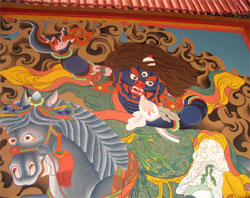Kumbum Monastery(Ta'er Monastery)

Kumbum Monastery is about 27 southwest of Xining. It is one of the two most
important Tibetan Buddhist monasteries outside Tibet itself. Set among flowing
wheat fields and fertile hills, the Ta'er Monastery evokes an ambience of
relaxation and meditation.
Kumbum Monastery, also called Ta'er Monastery, originated in 1379 from
a pagoda, which marked the birthplace of Tsong Kha-pa, founder of the
Gelugpa Sect in Tibetan people. The site covers around 400,000 square
kilometers and is home to over 75o monks.
The most famous items in this monastery are the "Three Treasures"-the
yak butter sculpture called "Suyouhua". Made from yak butter, the sculptures
bring to life Buddha, animals and flowers, varying from a few meters
tall to less than a centimeter. To prepare for the grand butter sculpture
show on the night of January 15 on the lunar calendar, the lamas must
start working at least three months ahead.
To prevent the butter from melting, they must work in sub-zero temperature
and the sculptures are kept in giant glass boxes with air-conditioning
after the show. Another treasure housed in this monastery is the appliqued
embroidery displayed in the Great Hall of Sutra. The pictures are pieced
together with silk and the Buddha. Mural forms another treasure of the
monastery. They were painted with pigments made from minerals and plants,
so the colors stay fresh and bright for centuries. But the most interesting
thing you will encounter here is the debate of the lamas.
Standing in front of his teacher who is seated, the student must think
of some difficult questions from Buddhist sutras, then clap his hands
as loudly as possible and extend his right arm to his teacher while
raising the question. Generally the teacher will answer succinctly with
one or two words.
Occasionally, he will speak longer and the students' smile clearly
shows his gratitude for the advice. Tourists are not allowed to watch
the debate, and if you show enough respect to the lamas, you might be
able to have an interesting talk with them. Do not miss out on the eight
stupas to the right of the entrance, representing the life story of
Sakyamuni.
|